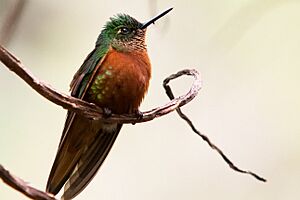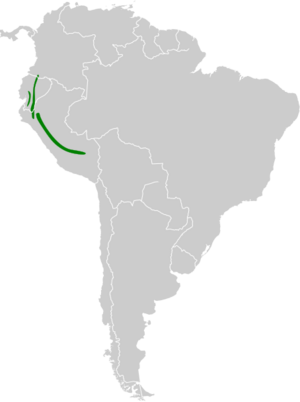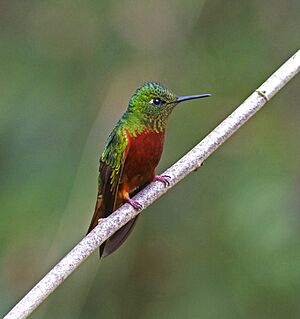Chestnut-breasted coronet facts for kids
Quick facts for kids Chestnut-breasted coronet |
|
|---|---|
 |
|
| At Machu Picchu, Peru | |
| Conservation status | |
| Scientific classification | |
| Genus: |
Boissonneaua
|
| Species: |
matthewsii
|
 |
|
The chestnut-breasted coronet (Boissonneaua matthewsii) is a beautiful type of hummingbird. It belongs to a group of hummingbirds known as "brilliants." You can find this bird living in the countries of Colombia, Ecuador, and Peru.
Contents
About the Chestnut-breasted Coronet
This special hummingbird is part of the Boissonneaua family. It shares this family with two other coronet hummingbirds: the Buff-tailed coronet and the Velvet-purple coronet. The chestnut-breasted coronet is a unique species, meaning it doesn't have different types or subspecies within its group.
What Does the Chestnut-breasted Coronet Look Like?
This bird is about 10.5 to 13 centimeters (4 to 5 inches) long. It weighs around 6.5 to 8.3 grams (0.2 to 0.3 ounces). Both male and female birds have a short, straight, black beak. They also have a white spot behind each eye. Their tail is notched, which means it has a small V-shape.
Males have shiny green feathers on their upper body. Their throat has yellowish-green spots on a light brown background. The rest of their belly is reddish-chestnut, with some green spots on the sides. The middle tail feathers are a bronze color. The other tail feathers are reddish-chestnut with bronze tips. Female birds look very similar to males. However, their underparts are a bit lighter, and they have fewer spots on their throat.
Where Does the Chestnut-breasted Coronet Live?
The chestnut-breasted coronet lives along the Andes mountains. You can find it from southeastern Colombia, south through Ecuador, and into Peru. It reaches as far south as the Cuzco area in Peru. It also lives on the western side of the Andes in central Ecuador and northwestern Peru.
This hummingbird prefers to live inside and at the edges of humid montane forest. These are forests found in mountainous areas. You might also spot them in gardens close to these forests. In Ecuador, they live at elevations between 1,600 and 3,300 meters (5,200 and 10,800 feet). They are most common between 1,900 and 2,700 meters (6,200 and 8,900 feet). In Peru, they can be found between 1,500 and 3,300 meters (4,900 and 10,800 feet) high.
How Does the Chestnut-breasted Coronet Behave?
Movement and Travel
Scientists don't know much about how the chestnut-breasted coronet moves around. It's not clear if they migrate or stay in the same area all year.
What Does It Eat?
The chestnut-breasted coronet is very protective of its food. It will defend groups of flowers from other birds that want to drink nectar. This bird usually looks for food in the middle and upper parts of the forest trees. It feeds by holding onto a flower. It keeps its wings open for a second or two after landing. Besides nectar, it also catches small insects. It does this by hawking, which means it flies out from a perch to catch insects in the air.
Breeding Habits
Not much is known about how the chestnut-breasted coronet breeds. It is thought that they build a cup-shaped nest, similar to other hummingbirds that are closely related to them.
What Sounds Does It Make?
People who have heard the chestnut-breasted coronet describe its calls. They say it makes a high, thin, liquid "tip" sound. It also has a fast, sweet trill and various squeaky notes.
Conservation Status
The IUCN (International Union for Conservation of Nature) has evaluated the chestnut-breasted coronet. They have listed it as a species of "Least Concern." This means that it is not currently considered to be in danger of extinction. The bird lives across a large area. However, its exact population size and whether its numbers are growing or shrinking are not known. No immediate threats to this species have been found.
It is considered uncommon to fairly common in Ecuador. In Peru, it is seen as uncommon to common. Human activities generally have little direct effect on the chestnut-breasted coronet in the short term. The main impact comes from local destruction of its forest habitat.



